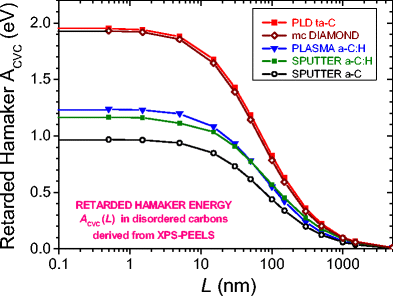Derivation of Hamaker Dispersion Energy of Amorphous Carbon Surfaces in Contact with Liquids Using Photoelectron Energy-Loss Spectra |
| |
| Authors: | Christian Godet Denis David |
| |
| Institution: | 1.Institut de Physique de Rennes (CNRS UMR 6251),Université Rennes 1,Rennes,France;2.Instituto de Física,Universidade Federal da Bahia, Campus Universitário de Ondina,Salvador,Brazil |
| |
| Abstract: | Hamaker interaction energies and cutoff distances have been calculated for disordered carbon films, in contact with purely dispersive (diiodomethane) or polar (water) liquids, using their experimental dielectric functions ε (q, ω) obtained over a broad energy range. In contrast with previous works, a q-averaged <ε (q, ω) > q is derived from photoelectron energy-loss spectroscopy (XPS-PEELS) where the energy loss function (ELF) < Im?1/ε (q, ω)] > q is a weighted average over allowed transferred wave vector values, q, given by the physics of bulk plasmon excitation. For microcrystalline diamond and amorphous carbon films with a wide range of (sp3/sp2 + sp3) hybridization, non-retarded Hamaker energies, A 132 (L < 1 nm), were calculated in several configurations, and distance and wavenumber cutoff values were then calculated based on A 132 and the dispersive work of adhesion obtained from contact angles. A geometric average approximation, H 0?CVL ?=?(H 0?CVC H 0?LVL )1/2, holds for the cutoff separation distances obtained for carbon-vacuum-liquid (CVL), carbon-vacuum-carbon (CVC) and liquid-vacuum-liquid (LVL) equilibrium configurations. The linear dependence found for A CVL, A CLC and A CLV values as a function of A CVC, for each liquid, allows predictive relationships for Hamaker energies (in any configuration) using experimental determination of the dispersive component of the surface tension, \( {\gamma}_{CV}^d \), and a guess value of the cutoff distance H 0?CVC of the solid. |
| |
| Keywords: | |
| 本文献已被 SpringerLink 等数据库收录! |
|

